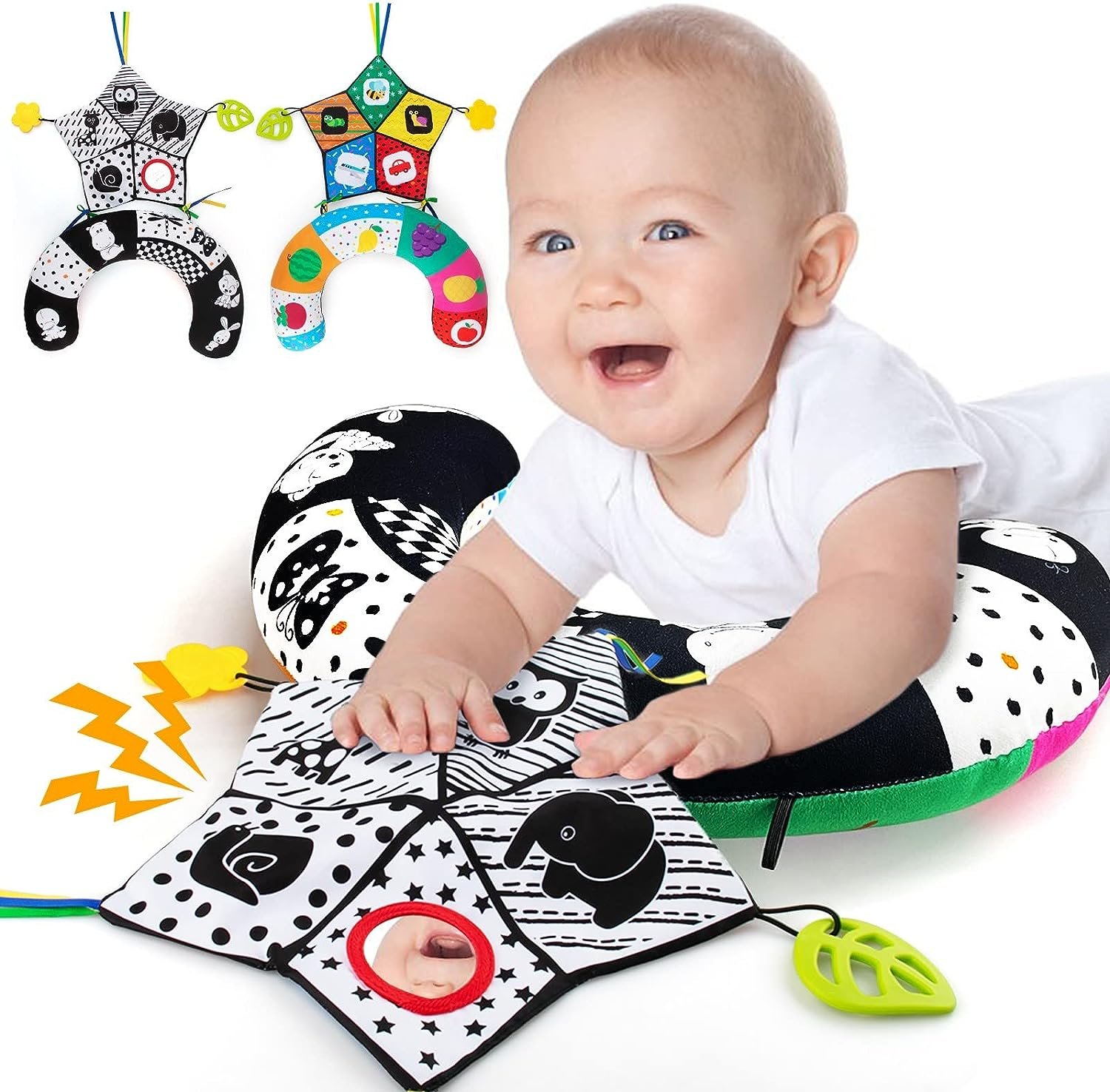What do I do if my baby hates Tummy Time?
Most parents understand that Tummy Time is important. It’s on the wellness checklists and Tummy Time products are heavily marketed to parents everywhere. Working in pediatrics, I’ve found that most parents know their babies should be getting Tummy Time, but..
they don’t know why, so when Baby doesn’t tolerate Tummy Time they don’t push the issue.
they don’t know how to facilitate Tummy Time if Baby is at all resistant to it.
It’s hard to buy in to a concept that we don’t understand, especially if it makes our babies cry. So in this article I’ll explain what constitutes Tummy Time, the benefits of Tummy Time, address the barriers to Tummy Time, and give troubleshooting tips for doing Tummy Time with fussy babies.
“A consistent trend among babies with delayed gross motor milestones is that they participated in little to no Tummy Time in early infancy. There are fairly predictive outcomes for Baby’s quality of movement when they skip this activity.”
What is Tummy Time?
Tummy Time refers to time Baby spends laying prone, or on their Tummy. The definition is pretty self-explanatory. However, this isn’t limited to laying flat on their tummies on the floor; Tummy Time can be achieved while Baby lays on their parent’s chest as the parent is reclined, while laying over their parent’s lap, being held in a “superman” position in their parent’s arms, and laying with a bolster beneath their chest to assist with lifting their head.
The point of Tummy Time is that Baby is below 45 degrees horizontal so that the back of their body has to work against gravity. Flat is ideal, but as we will see, babies that don’t tolerate laying flat on their tummies for long periods of time can still participate in Tummy Time… and they most likely need it even more.
When should Tummy Time start?
Tummy Time should start on Day One. Each of my babies were placed on their tummies in the hospital—flat in the crib and on my chest as I laid down. Unless there is a medical issue (such as an airway obstruction, tubes, etc.) babies can and should begin Tummy Time immediately.
How long should my baby stay on their tummy?
The gold standard for Tummy Time is 88 minutes a day. Remember, any of the above variations count toward Baby’s Tummy Time. This length of time has been correlated with typical gains in gross motor skills (rolling, crawling, sitting, etc.) and prevention of developmental delay (aka. skipping milestones or performing them poorly).
Benefits of Tummy Time
Stretching the hip joints
Full-term babies are naturally born with hip flexion contractures from being in the fetal position for a prolonged period of time in the womb. Notice how their legs hover when they attempt to straighten them when laying on their backs. Notice how they return to the fetal position for comfort in those early weeks. You’ll also notice that they can’t lay flat on their tummies initially; instead, they curl their legs up like little frogs with most of the weight on their chests. That is partly due to their hip flexion contractures, or short, tight muscles on the front of their hips.
As awkward as Tummy Time looks in the beginning, it is necessary to allow those tight hip muscles to stretch out.
(Of course, time on their backs is also necessary for this, but back time alone will not stretch those muscles out because Baby can rotate their hips, avoiding a direct stretch.)
Here is what we see in the clinic when newborns don’t work out their hip flexion contractures:
Inability to comfortably lay flat, causing issues with diaper changes, doctor’s assessments, age-appropriate playing, emotional regulation, etc.
Perpetuated low tolerance of Tummy Time, leading to poor or skipped rolling, which has implications for sitting and crawling.
Sitting with rounded posture because the hip tightness does not allow their pelvis and spine to move into the upright position.
Poor glute strength, causing delayed or abnormal standing and walking.
Gaining postural strength and control
… which prepares them for head control, rolling, crawling, and sitting. While Tummy Time for our newborn looks very passive to us, there is quite a lot going on in their bodies.
Their vestibular system is learning how be oriented in prone (stomach lying) so that when its time to roll in a few months, they are ready. When it’s time to crawl at about 8 months old, they are comfortable in that orientation because of the hours of Tummy Time, so they can focus on movement.
Even though they aren’t extending their back or lifting their head on their tummy as anewborn, Baby’s brain and postural muscles are receiving cues from gravity that lays the framework for anti-gravity movement that starts around 3 months.
This process is similar to how the language centers of the brain begin learning how to form words the minute they hear our voice, though they won’t actually speak for months. We would never wait to speak to our babies until they could answer; in the same way, we shouldn’t wait until they are ready to crawl to place them on their tummies. They wouldn’t know how move their bodies in space, just as they wouldn’t know how to form a word.
Postural strength and control starts with head control. Babies should be able to hold their head steady when held upright, and help pick their heads up when lifted from a flat surface, by around 3 months. At this time, they should be picking their head up in Tummy Time in order to look around. This strengthens their neck and back muscles in preparation for other skills.
Postural strength is positively connected with cognitive development. When the muscles that extend the spine are activated, the brain is more alert; more neural connections are made. The opposite of this is when our bodies are curled up, or our back muscles are turned off, our brains are less alert. We absolutely see this in the clinic. Babies who have poor postural strength are less alert, communicate less, are more passive, and meet other cognitive, speech and communication milestones later.
Have you ever heard of Power Posing? The same principle is true for our babies!
Setting Baby up to achieve other gross motor skills in a healthy window
Babies who engaged in little to no Tummy Time tend to skip rolling. There are many babies whom I have worked with at 6 months old on rolling because now they aren’t able to sit. It is fairly easy to miss the fact that Baby isn’t rolling, or only rolls accidentally, but parents tend to notice when other babies are sitting and their Baby is not. If Baby does not roll properly, their abdominal muscles will have no rotational strength and control needed for proper sitting, transitioning to and from the floor, and crawling.
Babies who did not spend time on their tummies have poor rotational strength, which keeps them from transitioning from the floor to sit and back. This limits their ability to scan and engage with their environment, robbing them of cognitive development opportunities. This teaches them to be more passive and less autonomous because they have reached an age where they should be able to independently change their position, but they cannot.
Babies who did not perform Tummy Time sit with poor posture, often propping with their hands. This means they are not free to hold toys, which can lead to cognitive and communication delays. More importantly, poor sitting posture directly impacts feeding and nutrition. Babies cannot safely eat until they can sit independently with good postural control. Sitting with rounded posture is a choking hazard, along with the fact that babies have less control and dexterity when core strength is poor, so they are unable to self-feed. This perpetuates passivity and impacts their autonomy. Babies with weaker core and postural muscles tend to stay on pureed food longer, tend to be pickier eaters, and tend to have nutritional issues that need to be addressed by occupational therapists or speech/feeding therapists.
These delays bottle neck to cause future delays in crawling, standing, walking, eating solids, speaking, cognitive development, etc. that we won’t go into in depth.
Integrate primitive reflexes
Babies are naturally born with reflexes that are later replaced by intentional movement. However, if the reflexive movement persists, it “collides” with Baby’s intentional movement, delaying skills or causing awkward movement. I’ll talk more about primitive reflexes in another post.
These natural and healthy reflexes each serve a purpose, then need to move out the way at a certain time. The way these reflexes are replaced, or integrated, is through movement. Pretty simple, but extremely detrimental if it doesn’t happen. Each time we restrain Baby in equipment, we are removing an opportunity to move and integrate their primitive reflexes.
Tummy Time specifically helps to integrate certain primitive reflexes so that future skills can be achieved in a healthy window of time and in a coordinated way.
Retained primitive reflexes can cause not only developmental delay and coordination issues, but issues with feeding, bedwetting, vision, emotional regulation, and more.
Barriers to Tummy Time and what to do.
Acid reflux/GERD/silent reflux
This issue is exacerbated when placed flat, especially when laying on the tummy. If Baby fusses within seconds of being placed on their tummy and/or if Tummy Time fussing is worse within 30 minutes of eating, this may be the cause.
If you know your baby is struggling with reflux, I would recommend looking into the root cause (diet, trunk restrictions, feeding habits, etc.) prior to medicating them. Medication often masks symptoms. Disclaimer: as a clinical doctor I do not give medical advice. If you are worried about possible reflux, please consult a medical professional.
Trunk restrictions/torticollis
Torticollis is a condition where stiffness in a neck muscle that causes Baby to consistently hold their head rotated and/or tilted to one side. Baby may be fine laying on their tummy with the head rotated to the preferred side, but may fuss when the head is placed to the other side.
Restrictions in the neck are fairly obvious, but the often “silent” symptom that goes along with this are restrictions in the trunk. Trunk restrictions can also be present without torticollis. Laying on the tummy may cause Baby to be uncomfortable if they feel pulling from tight muscles or fascial restrictions. This can cause immediate or delayed fussing when placed on the tummy.
If you notice or suspect torticollis or trunk restrictions, have your baby assessed by a pediatric physical therapist, preferably one with specific training in torticollis and myofascial release. Each of the PTs in our practice have undergone extensive training in these areas.
Vestibular sensitivity
Typical babies process sensory information along a spectrum. Some are more sensitive to touch, sounds, and even movement. The act of being rotated on laid on the tummy may overstimulate Baby, causing them to fuss.
You can build up Baby’s tolerance to position changes by moving them more slowly, preparing them by saying the same script to them each time (such as smiling while you say, “It’s time to lay on your tummy! Let’s go!”), laying them over your lap, laying down with them, and providing low stimulation distraction while on their tummy (such as singing to them, rolling a ball slowly back and forth in front of them, etc.) Practice this multiple times a day to form a habit and pick them up as soon as they fuss, but do it again later. They will learn that it is a safe place to be, they won’t be “stuck” there, and their brains will desensitize to the awkward sensation. Any time is better than no time!
Time in Positioners.
Any chance for free and natural movement that is replaced with time in a baby swing, bouncer, activity/exercise saucer, jumper, etc. is a chance that Baby is missing to strengthen their body and integrate their reflexes. See my post on Positioners for a full explanation.
“Limiting Baby’s time in baby equipment will help them develop healthy habits of movement, like Tummy Time. ”
Interested in a 1 on 1 consult with me? I would love to answer your questions about your baby’s development!
PT-approved Tummy Time helpers
(Turn phone sideways to see caption. Click photo for link)



This post contains affiliate links for products I use and/or endorse. This helps to fund my business at no extra cost to you.
Did you know the CDC changed many developmental milestones to a later age, and removed crawling altogether from the list of normal developmental skills? I’ll explain why, and how this impacts our children in this post.




